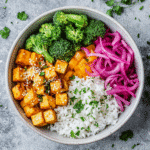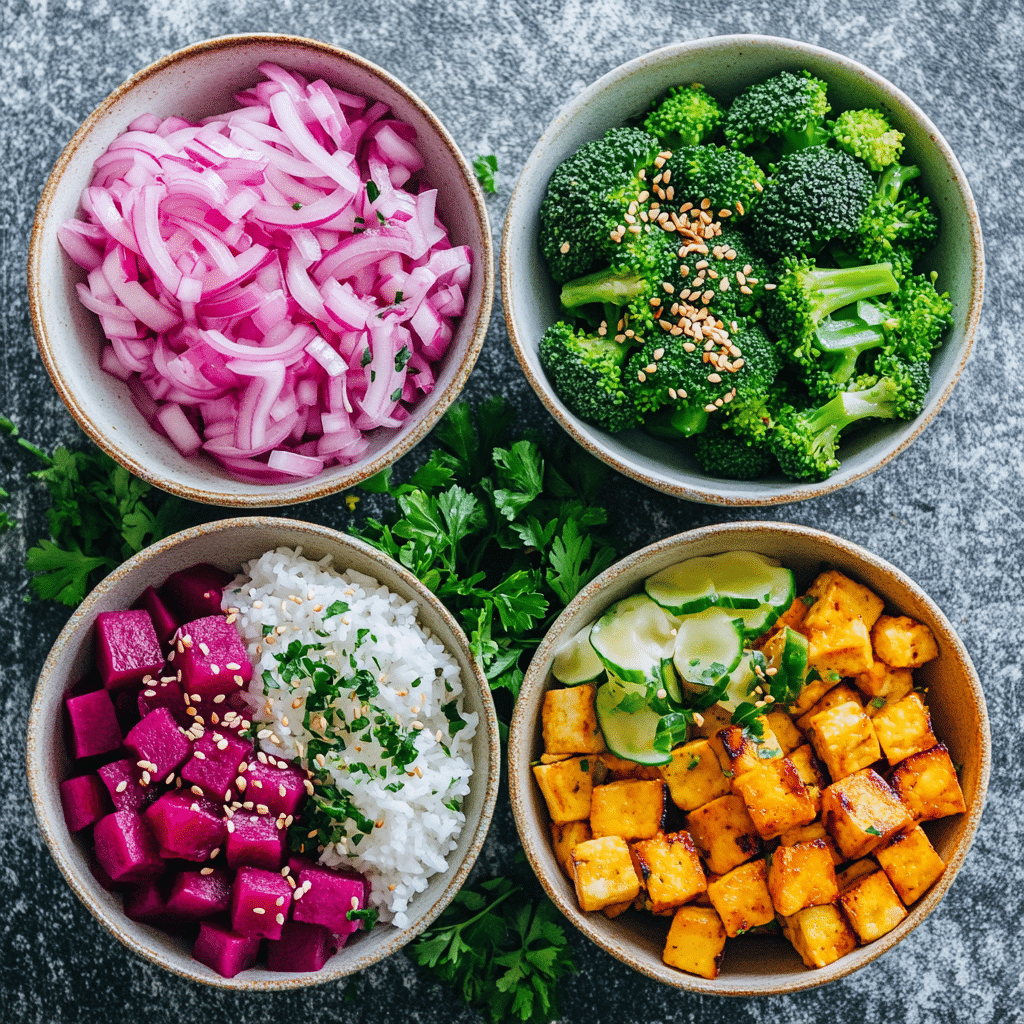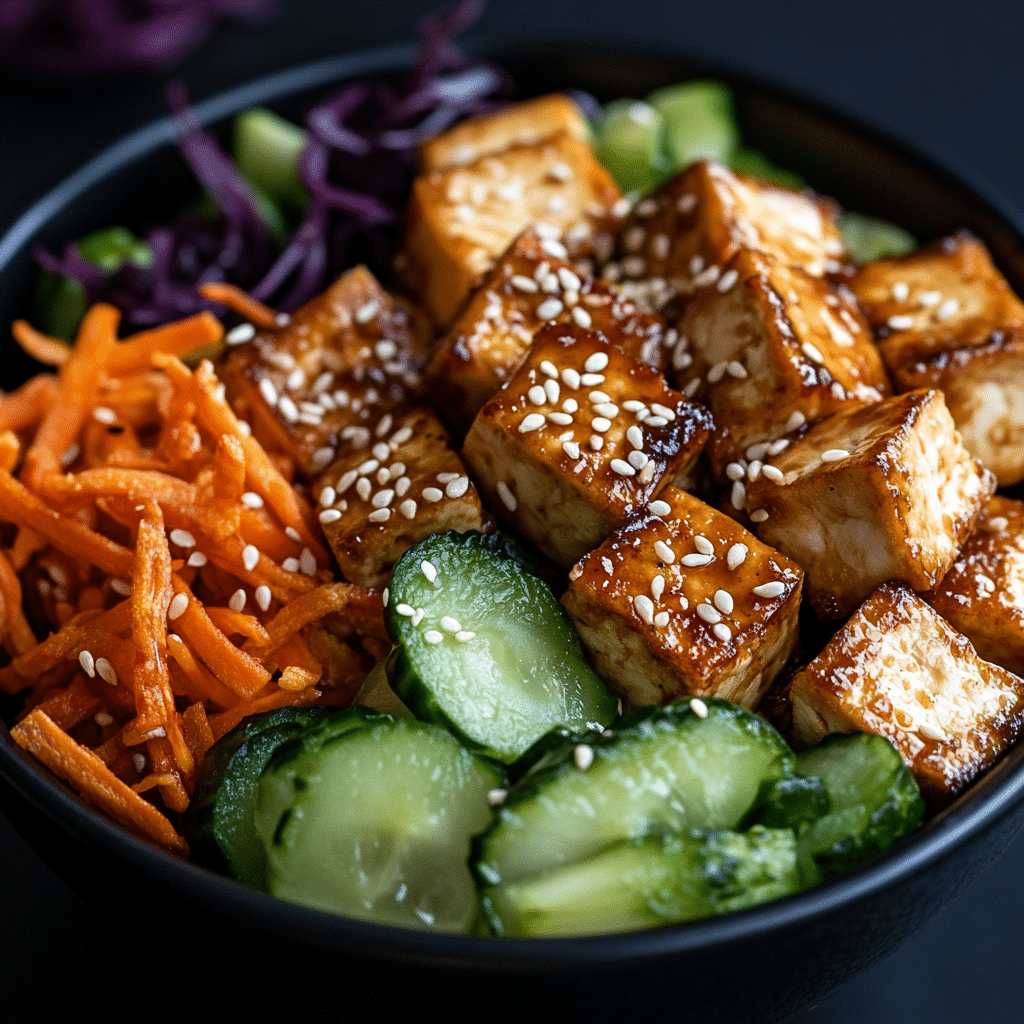When I first discovered Buddha bowl recipes, it felt like uncovering a colorful secret to healthy eating. Picture this: a deep, cozy bowl layered with vibrant grains, crisp veggies, creamy avocado, and a drizzle of tangy tahini sauce. It was love at first bite. These bowls weren’t just beautiful—they were practical, delicious, and left me feeling full and energized. For women like me, in our 40s and beyond, craving ease without sacrificing nutrition, Buddha bowls offer a perfect solution. This article walks you through exactly what goes into a Buddha bowl, why they’re great for weight loss, and how to top them off with flavorful sauces.
Print
Buddha Bowl Recipes: A Wholesome Guide to Balanced Eating
- Total Time: 35 mins
- Yield: 4 1x
Description
Prep these simple components ahead of time to pack this healthy Buddha bowl for lunch, or make it for an easy weeknight dinner! Vegan and gluten-free.
Ingredients
1 large sweet potato, cubed
Extra-virgin olive oil, for drizzling
1 watermelon radish or 2 red radishes
2 medium carrots
1 cup shredded red cabbage
Lemon wedge, for squeezing
8 kale leaves, chopped
2 cups cooked brown rice or quinoa
1 cup cooked chickpeas or cooked lentils
¾ cup sauerkraut or other fermented veggie
2 tablespoons sesame seeds or hemp seeds
Turmeric Tahini Sauce, for serving
Microgreens, optional
Sea salt and freshly ground black pepper
Instructions
1. Preheat the oven to 400°F and line a large baking sheet with parchment paper.
2. Toss the sweet potatoes with olive oil, salt, and pepper, and spread onto the baking sheet. Roast for 20 minutes, or until golden brown.
3. Thinly slice the radish into rounds (best done on a mandoline), and use a vegetable peeler to peel the carrots into ribbons.
4. Toss the radish slices, carrots, and shredded cabbage with a squeeze of lemon. Set aside.
5. Place the kale leaves into a large bowl and toss with a squeeze of lemon and a few pinches of salt. Massage the kale until it softens and reduces in volume.
6. Assemble individual bowls with the brown rice, chickpeas, kale, carrots, radishes, cabbage, sweet potatoes, sauerkraut, sesame seeds, and microgreens, if using.
7. Season with salt and pepper and serve with the Turmeric Tahini Sauce.
Notes
You can substitute sweet potatoes with roasted squash.
Use any fermented vegetables you enjoy in place of sauerkraut.
Works equally well with brown rice or quinoa as the grain base.
- Prep Time: 15 mins
- Cook Time: 20 mins
- Category: Lunch, Dinner
- Method: Assembly
- Cuisine: Plant-Based, Vegan
Understanding the Core of Buddha Bowl Recipes
The Five Essential Components of a Buddha Bowl
The magic of Buddha bowl recipes lies in their structure—each element contributes to both flavor and nutrition, creating a complete meal in a single dish. Whether you’re building a quick lunch or a thoughtful dinner, these five components serve as the base for any satisfying Buddha bowl.
- Whole Grains: This is your hearty foundation. Think nutty quinoa, chewy farro, fluffy brown rice, or even barley. Grains provide the complex carbs that keep energy levels steady and help you feel full longer.
- Plant-Based Proteins: Here’s where you pack in the sustenance. Chickpeas roasted with spices, grilled tofu, lentils, or edamame are all protein-rich options that complement the bowl’s other textures.
- Fresh and Cooked Vegetables: This is your chance to go wild with color and crunch. Use a mix—raw cucumbers, shredded cabbage, or cherry tomatoes alongside roasted sweet potatoes, Brussels sprouts, or steamed broccoli.
- Healthy Fats: Including fats like avocado, nuts, olive oil, eggs, meats, and nut butters can help maintain hormonal balance and naturally curb cravings.
- Flavorful Sauces or Dressings: A great sauce is what ties it all together. Whether you opt for creamy tahini, a citrus vinaigrette, or a bold peanut sauce, this finishing touch brings cohesion and zing.
Each classic Buddha bowl recipes is built around five foundational elements, ensuring a harmonious mix of flavor, texture, and nutrition in every bite. Once you get comfortable with these basics, your creativity can really shine.
Typical Ingredients Found in Buddha Bowls
Though the components are consistent, the ingredients in Buddha bowls are endlessly customizable. A typical bowl might start with a base of quinoa, brown rice, or even cauliflower rice. Add some seasoned tofu or spicy roasted chickpeas for protein. Next, layer in vibrant touches like shredded carrots, tender kale, and roasted zucchini to create a colorful, nutrient-dense medley.
Toppings add fun and texture. Sliced avocado, pickled onions, a handful of toasted sesame seeds, or even a swirl of hummus can elevate the bowl. And don’t forget a vibrant sauce—creamy tahini with lemon and garlic is a go-to, but you can also try a miso-ginger drizzle or a simple olive oil and lemon combo.
Sample Ingredient Layout (as shown in image)

- Diced golden beets
- Pickled red onions
- Steamed broccoli florets
- Cubed grilled tofu sprinkled with sesame seeds
- Herbed cooked white rice
- Fresh parsley garnish
Option: carrots, whether shredded raw or peeled into ribbons, add a sweet crunch and bright color that pairs beautifully with roasted or steamed veggies.
Whether you’re making a bowl for lunch at home or prepping for the week, the versatility of Buddha bowls keeps things exciting. They adapt easily to what’s in your fridge—and that’s the beauty of them.
Health Benefits and Weight Management
Are Buddha Bowls Healthy for Weight Loss?
If you’re aiming to eat lighter without skimping on flavor, Buddha bowl recipes might be your new best friend. They’re naturally rich in fiber, low in processed ingredients, and easy to portion—all essential factors for sustainable weight loss.
One of the key reasons Buddha bowl recipes support weight loss is satiety. The combination of complex carbohydrates from grains, lean plant proteins like chickpeas or tofu, and water-rich vegetables helps you feel full longer. In addition, nourishing fats from avocado or seeds help balance hormones and may curb the urge for less healthy options.
One of the best things about Buddha bowl recipes is how effortlessly they adapt to your preferences. You can control the calorie count by adjusting the portion sizes, choosing low-calorie dressings, and focusing on nutrient-dense veggies. Take a bowl layered with quinoa, roasted cauliflower, crisp cucumber, grilled tempeh, and a touch of tahini—it’s filling, flavorful, and supports healthy eating goals.
In fact, studies show that meals rich in plant-based ingredients, like those found in Buddha bowl recipes, often lead to better weight management outcomes. It’s not about cutting out food groups—it’s about embracing balance in every bite.
Nutritional Advantages of Buddha Bowl Recipes
Beyond weight loss, Buddha bowl recipes are nutritional powerhouses. Each element delivers specific health benefits, contributing to overall wellness in a balanced, delicious way.
Whole Grains: These provide steady energy, thanks to their fiber and B-vitamin content. They aid in digestion and help maintain steady blood sugar throughout the day.
Proteins: Lentils, tofu, and other plant-based options supply the essential amino acids your body relies on. They help with muscle repair, immune function, and metabolic health.
Vegetables: The wide variety of colorful veggies brings antioxidants, vitamins A, C, and K, and minerals like potassium and magnesium into your diet.
Healthy Fats: They enhance the uptake of fat-soluble vitamins and contribute to cognitive function and brain vitality. Even adding a slice of avocado or a spoonful of seeds can significantly boost the bowl’s nutritional value.
By combining all these elements, Buddha bowl recipes create a synergistic meal that promotes gut health, supports a healthy heart, and keeps your energy levels stable. For women over 40, this kind of thoughtful nourishment becomes even more important. Meals like simple kitchen wins are not just feel-good—they’re functional.
Exploring Sauce Options for Buddha Bowls
Popular Sauces to Complement Your Buddha Bowl
Let’s be honest: a great sauce can turn a decent Buddha bowl recipes into something unforgettable. It’s that flavorful bridge tying together your grains, veggies, and proteins. From bold and spicy to smooth and tangy, sauces can mirror any craving or flavor mood.
A fan favorite among Buddha bowl recipes toppings is a smooth and rich tahini-based dressing. Crafted with tahini, fresh lemon, garlic, a hint of water, and just a touch of salt, this dressing delivers indulgent simplicity. It’s also loaded with calcium and iron—a plus for bone health.
Peanut sauce is another go-to, especially if your bowl leans Asian-inspired. Mix peanut butter, soy sauce, lime juice, maple syrup, and a touch of ginger for a savory-sweet blend that clings beautifully to grains and tofu.
If you’re after something lighter, try a miso-ginger vinaigrette. Blend white miso, freshly grated ginger, rice vinegar, and sesame oil to create a bold, savory sauce bursting with umami flavor. This one pairs perfectly with roasted vegetables like sweet potatoes or Brussels sprouts.
Then there’s the cilantro-lime vinaigrette—bright, citrusy, and herbaceous. Blend olive oil, fresh cilantro, lime juice, and a dash of honey. It’s especially refreshing with bowls based on quinoa or wild rice.
Not sure where to start? Check out our mocktail and drizzle ideas for flavor inspiration. Even a basic olive oil and balsamic combo can work wonders with the right ingredients.
Crafting Your Signature Sauce
Once you get comfortable, making your own Buddha bowl recipes sauce is as intuitive as mixing salad dressing. Begin with a base—like tahini, nut butter, Greek yogurt, or avocado. Then, choose an acid such as lemon juice or vinegar to brighten it up.
Layer in your flavor: fresh herbs, garlic, ginger, mustard, or spices like cumin or smoked paprika. Sweeteners like maple syrup or honey can round out any bitterness. Thin it out with water, olive oil, or plant-based milk until it reaches your ideal texture.
The possibilities are endless. Try adding turmeric for anti-inflammatory benefits or chili flakes for heat. With practice, you’ll create go-to sauces that match your favorite combinations—and you might even find a signature bowl blend you return to again and again.
Building and Customizing Your Buddha Bowl
Step-by-Step Guide to Assembling a Buddha Bowl

Creating a Buddha bowl recipes isn’t just a recipe—it’s an art form you can make your own. Follow these simple steps, and you’ll have a vibrant, nutrient-packed meal that’s just as fun to build as it is to eat.
- Start with the base. Scoop a serving of cooked grains into the bottom of your bowl. Quinoa, brown rice, wild rice, or farro work well. For a low-carb version, try cauliflower rice or shredded cabbage.
- Add your protein. Place your protein choice on top of the grains. This could be grilled tofu, roasted chickpeas, boiled eggs, tempeh, or even leftover chicken or salmon if you’re not strictly plant-based.
- Layer on the veggies. Use a mix of raw and cooked vegetables for texture and flavor. Think roasted carrots, steamed broccoli, fresh spinach, sliced radishes, or sautéed zucchini.
- Include healthy fats. A few slices of avocado, a drizzle of olive oil, or a sprinkle of hemp or pumpkin seeds can make your bowl more satisfying and nutrient-rich.
- Finish with a sauce. Drizzle your favorite dressing right before serving. Don’t be afraid to mix it up—yesterday’s lemon-tahini might be today’s spicy peanut!
- Top with extras. Crumbled feta, nutritional yeast, microgreens, or even a spoonful of sauerkraut can add layers of taste and nutrition.
Tips for Personalizing Your Buddha Bowl
The best part about Buddha bowl recipes is how easily they bend to your preferences. Start by using what’s in your fridge—those last bits of roasted vegetables, that small handful of greens, or a half-used can of beans. No waste, and every bite has a purpose.
Switch up your grains weekly: quinoa one week, brown rice the next, maybe even couscous or millet. Changing the protein can keep things fresh too—roasted chickpeas one day, leftover salmon the next. If you’re low on time, try store-bought hummus or pre-cooked lentils for ease.
You can even match your bowls to the season. Try roasted root veggies and warm grains in winter, and fresh cucumbers, cherry tomatoes, and light vinaigrettes in summer. With such flexibility, Buddha bowls can suit any season or mood.
And don’t be shy with the sauce! A good dressing can transform the whole experience. Want to dive deeper? Our quick dinner ideas often build on the same bowl-building philosophy—quick, balanced, and brimming with flavor.
For more recipes, follow my in Facebook and Pinterest
Conclusion
Buddha bowl recipes offer more than just a pretty plate—they’re a practical, health-forward way to eat well with minimal stress. Whether you’re looking for a weight loss-friendly meal or a colorful dish to break your routine, these bowls invite creativity and nourishment in every bite. Try switching up your grains, veggies, and sauces to keep things fresh, and don’t forget—what you put in your bowl is just as important as how it makes you feel.
FAQs About Buddha Bowl Recipes
What are the 5 components of a Buddha bowl?
The classic structure of a Buddha bowl recipes includes whole grains, plant-based protein, vegetables (raw or cooked), healthy fats, and a flavorful sauce or dressing. This balance ensures a nutritious, satisfying meal every time.
What is usually in a Buddha bowl?
Buddha bowl recipes typically contain a grain like quinoa or rice, a protein such as tofu or beans, various vegetables (spinach, sweet potatoes, carrots), toppings like avocado or nuts, and a sauce—most often tahini or vinaigrette—to bring it all together.
Are Buddha bowls healthy for weight loss?
Yes, they are. Buddha bowl recipes combine fiber-rich grains, lean proteins, and nutrient-dense vegetables, helping to keep you full and energized. When built thoughtfully, they support calorie control without sacrificing satisfaction.
What sauce goes on a Buddha bowl?
The sauce is where flavor shines. Buddha bowl recipes- Tahini-based dressings, miso-ginger vinaigrettes, peanut sauce, or cilantro-lime dressings are common favorites. You can also experiment with yogurt-based or avocado sauces for variety.
